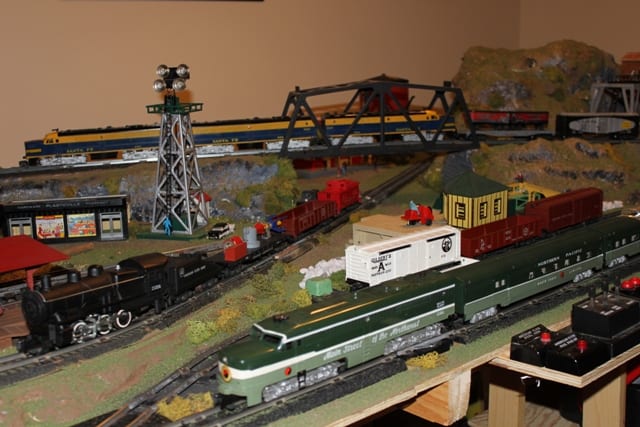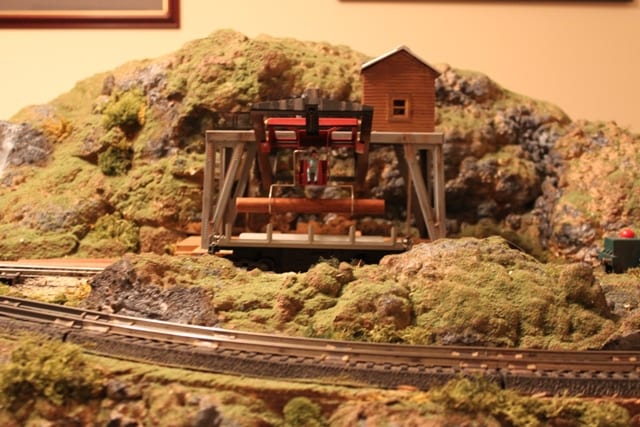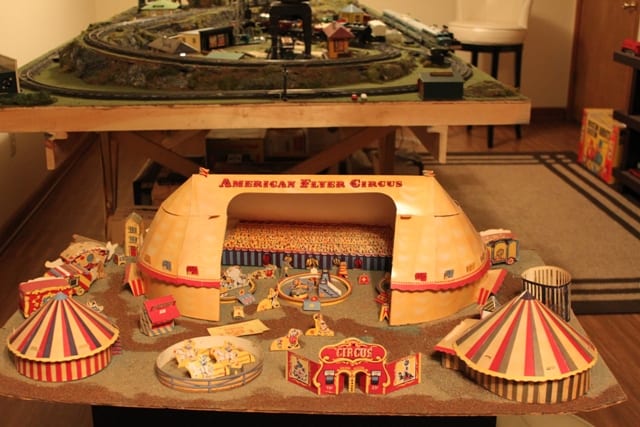My Collecting Odyssey: From Lionel to American Flyer (and everything else in between)

By Chip Kessler TCA #15-71537 Summer 2017
EDITOR’S NOTE: This story is much like the movie “Toy Story.” Much like the toys in the movie, the collectibles are never sure if they will survive! Our hero, Chip, starts by collecting baseball cards, then to toy trains, then to vintage baseball games, then to comic books, and then (tada!) back to trains. I must say that this collector shares our passion for the hobby, and so much more!
Growing up in Philadelphia there wasn’t much money so my collecting endeavors in the late 1950’s and 60’s was limited to some baseball cards. Yes, the cards were thrown out (the usual well- meaning protagonist here: my mother on a cleaning binge when we moved from our apartment at the time to another).
Fast forward to adulthood, and the collecting bug bit me hard- a brief foray back into baseball cards (as well as football cards) in the late 80’s. What cards I was able to amass eventually were sold to a local dealer in my now home area of Northeast Tennessee. Indeed I was able to turn a profit, and with this stake entered the world of Lionel trains.
I’d always liked trains, and can vaguely remember riding on the old Pennsylvania Railroad as a little boy. I also took several trips on the Amtrak Metroliner between Philadelphia and New York City in the 1970’s. That was my entire train experience because I never had model trains.
When I decided to buy my first train set in 1991 there was only one place to go here in Johnson City, TN- Jack Miller Trains. Yes there were a few other train shops in the region back then however Jack’s was the focus of those looking for Lionel. Why Lionel for me? Because I liked the size, and during my study of what was offered, especially liked the play value of Lionel operating accessories.
Jack Miller (a long-time TCA member who has since passed on) ran a very successful auto body shop in town. Behind the business was a non-descript building, which to the uninitiated, was just that- a building where you might have thought was either a storage spot for body shop related items or just an unused space. Lionel train aficionados in the area knew otherwise.
I can’t recall how I discovered Jack Miller sold trains. What I can remember was the amount of Lionel product in stock, mostly newer items dating back to the 1980’s and beyond, plus a little postwar. When MTH came on the scene, Jack was also a strong proponent of their product. In the next few years I slowly built a collection of trains and accessories, even going as far as to obtain some of the postwar classic accessories like the Forklift Platform, Culvert Loader and Unloader, and the Sound Dispatching Station from outside sources. With the assistance of my father-in-law who was a carpenter, I soon had a professional built train table and was “off and running” so-to-speak, thought I didn’t have much in the way of scenery on the layout.
By the end of the 1990’s however, the trains and layout were no longer holding my attention, hard as it is now to have to write this sentence. The lure of collecting something else took hold, and I decided to sell my trains and the train table as well! Over the next few years I began acquiring vintage baseball games produced from the early 1900’s through the 1960’s (I’d happened to have read a book on these games and became intrigued). Greats of the game such as Babe Ruth, Christy Mathewson, Lou Gehrig, Jackie Robinson, and many other stars had lent the names and faces to promote such authorized games and I was right in the middle of buying them. I’d acquired a large majority of these games, only a few years later to heed the call of the collecting siren once again. The result- I’d contacted a major sports memorabilia auction house and the games were shipped off and sold to the highest bidders.
Next up were what are called Golden Age comic books from the 1940’s and 50’s. As before, I went after my chosen books from this period with vengeance! As in the past, I was able to purchase a large segment of my targeted desires. Would this be my final collecting stop?
In a word no. I’m going to lay the blame here (tongue in cheek) on TM Books & Videos! Quite by accident one day I’d discovered the “I Love Toy Trains” program on the RFD television network, one of the upper tier channels on my satellite TV system. I’d just been flipping through the channel guide one day and saw the listing for this show. I wondered what it exactly was about. When I watched, I quickly saw who the producers were – the aforementioned TM.
Having been familiar with the company because I’d purchased just about all of their train videos during my Lionel days, I very much enjoyed the program, and made it a point thereafter to DVR the show to watch. Week-by-week I become more enthused, remembering my enjoyment of the hobby. The more I watched that show, the more I thought back to those days! But wait I moment I thought; I’d had trains and sold them. Did I want to get back in and just re-acquire what I formally had? Plus my father-in-law had passed away so the idea of even asking/begging him to build me another train table was out of the question (FYI: I’m not blessed with any kind of carpentry skills).
Yet the urge was too strong to resist. I would get back into trains once more however this time with American Flyer. I’d always been intrigued with Flyer even in my Lionel days. I’d liked that it was a little smaller in size (so you could get more on a layout) but still close enough to have some substance plus they also had their fair share of operating accessories. Fact was I’d bought the Lionel-American Flyer reissues of the oil drum loader and sawmill from Jack Miller Trains for my previous layout. In addition to going with American Flyer this time around, I also made the decision to mainly focus on postwar trains and accessories, another switch from my earlier time of mainly running newer engines, freight and passenger cars.
So the comics were sold to a well-known national comic’s dealer, and the funds derived from this sale were used towards my return to toy traindom. My first task was to decide on how and where to get a layout to operate any future trains. My hope was to have a layout built, and after reviewing a few potential custom layout builders, chose Brian Inch of Model Rail Scenes out of Maine.
I wasn’t after much in the way of size. This time around, an opposite room in the downstairs of my ranch style home would be used, and the designated space served to accommodate a 6 x 12 pike. And while I’ve always admired those layouts that feature five or ten or thirty trains operating at the same time, I wouldn’t be comfortable with having to keep up with so much activity, even if I had the space! While my previous Lionel layout was L-shaped and had three trains going at once, my new American Flyer version features two train operation. The loops aren’t even connected, as per my instructions to Brian. The outer loop runs around the perimeter of the table while the inner loop is a partially raised figure eight. There’s a mountain on the right where the trains pass by, plus two sidings on the inner loop and two passing siding on the outside loop.
As before, accessories play a large role – mostly postwar pieces from the 1950’s such as the Oil Drum Loader featuring “Louie the Loader,” the baggage loading platform, and the milk stand. I also have a postwar American Flyer water tower and the Guilford Passenger Station, along with the Mystic Talking Station. 1950’s Mini-Craft buildings such as the three-piece Whistle Stop Set (news stand, passenger shed, and hot dog stand), the Harbor Junction Station, and the Eureka Diner are also on the layout in various places. In addition, there are a few newer pieces such as the Lionel-American Flyer reissued Gabe the Lamplighter, Log Loading Platform (I did have the postwar version on the layout first, and mine just wouldn’t operate very well so I replaced it with the newer model), plus a Brian Inch modified operating Gantry Crane gets plenty of work as well.
I do have one postwar Lionel accessory on the layout now, and this is an interesting story. As I earlier mentioned, on my previous Lionel pike I had the 264 Forklift Loading platform and always liked the piece. It got me to thinking if it was possible to also use it on my American Flyer layout? Certainly I figured the accessory itself would work, and I did have space for it; however the accompanying Lionel flat car with the raised platform to house the pieces of lumber wouldn’t be compatible at all.
Enter Larry Moore. I was fortunate to meet Larry at a train show in Asheville, NC a short while after I got back into the hobby. Besides being a wonderful gentleman who’s become a great friend, Larry is an expert postwar American Flyer repairman who’s also a whiz at restoring and tuning up AF pieces. My question to Larry was whether or not he could take a conventional American Flyer flatcar and turn it into a version of the Lionel car that would carry the forklift pieces of lumber? Larry has yet to tell me “no” on anything and was up to the challenge! I found a 264 and car on E-bay, bought it, had it shipped directly to Larry were he went to work. The end result is that I now have my old favorite on my new layout.
Larry’s been an invaluable resource. I’ve gone after many of Flyer’s top postwar sets (my interest is sets in their original box if possible) and I’ve brought him just about all of the engines to check out and lube to make sure they are in top running condition. Among my acquisitions include such 1950’s stalwarts as the Circus Train, Silver Comet Passenger Set, The New Trailblazer Freight Set; The New Pacemaker Freight Set, The Chief Freight Set (the blue and yellow A-B-A with accompanying cars), The Keystone Rocket Freight Set; The North Coast Limited Passenger Set; The Defender Freight Set; The Merchandiser Freight Set; The Pathfinder Freight Set, as well the legendary Pony Express Passenger Set. I especially like the fact the A.C. Gilbert Flyer saw fit to name the sets- I think it adds quite a bit to their attraction!
I also have a few modern issues from Lionel American Flyer: The Blue Comet Passenger Set; the Chicago & Alton Passenger Set, plus the New York Central Passenger Set. No matter the time period, I like to run my sets as they were offered, and not mix different cars (freight or passenger) with different engines.
I’ve gotten some of these sets on E-bay. I’ve also been fortunate to become acquainted with Clay Kinsner of Lone Star Trains and Collectibles. I’d been looking to buy and Clay had recently purchased a large American Flyer collection so it was a good situation for the both of us. Clay’s another good source for information and guidance. Yes, I’m his customer but he’s been great to talk to about American Flyer trains, and has become a good friend.
So that’s my story; from Lionel to American Flyer and other stuff in between. Perhaps you’re wondering if my days of shifting from one collectible to another have ended. Indeed they have! I think it has to do with finally settling down at age 63 and enjoying what I can see before me. My wife’s also been very tolerant of my floating around from one thing to the next however I’ve learned a valuable lesson- appreciate what you’ve been blessed with and get the most out of it. Come to think of it, that’s a good lesson to follow no matter what we are facing in life!










